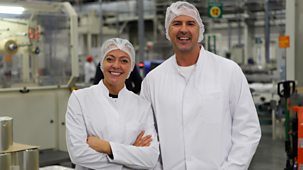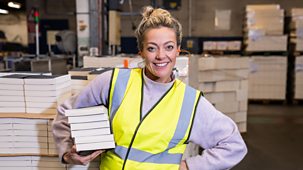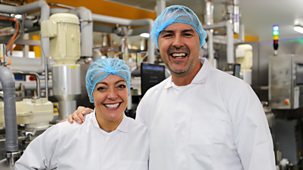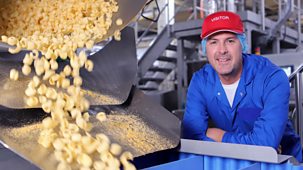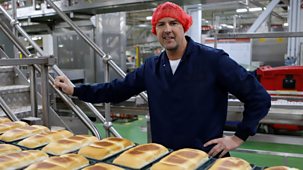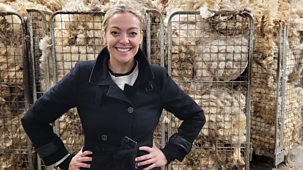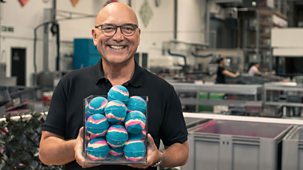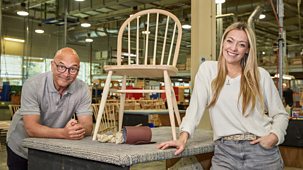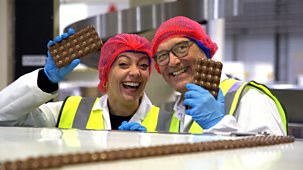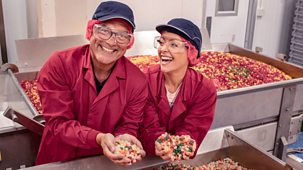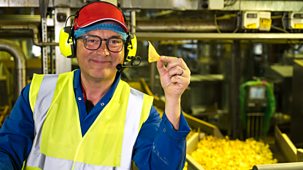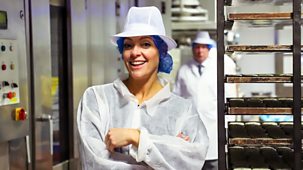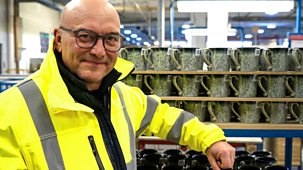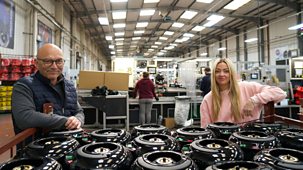
Series 6: 10. Vacuums
Gregg Wallace visits a huge vacuum cleaner factory in the heart of Somerset. This 32-acre site is a hive of activity where 1.2 million vacuums are made every year. Gregg is following their biggest seller, the Henry vacuum cleaner in bright red.\n\nHe starts with head of operations Stuart Cochrane, who is taking delivery of 25 tonnes of clear polypropylene pellets. They are transported to the factory floor via a spaghetti junction of pipes and then mixed with a red colouring agent. A massive moulding machine heats the plastic pellets and forces them into a drum-shaped mould under 300 tonnes of clamp pressure, the equivalent weight of 24 London buses. There are 47 of these huge moulding machines in the factory, churning out a total of 5,000 vacuums every day.\n\nNext, Gregg’s vacuum needs a bit of personality. The famous smile was drawn on for the first time as a joke by an employee at a trade show, but it attracted so much attention that it quickly became a permanent fixture. It is created using a process called PAD printing. Silicone pads are dipped in ink and pressed onto the surface of the moulded plastic ‘face’ to create the eyes and smile, after which it is cured under heat to dry the ink.\n \nWith the drum and face moulded and printed, and wheels made from moulded recycled plastic, the bottom half of the vacuum is assembled in less than a minute. Timing is crucial - the drum is still hot from the moulding machine, so the wheels must be slotted in before the plastic cools and shrinks. \n\nNow for the top half of the vacuum cleaner, which starts with a moulded motor housing. The motor needs power, so Gregg meets with wiring section manager Nathan Bandy at the loom assembly station. Nathan explains that the wiring loom is a cluster of cables that connect to the on/off switch, transmitting electricity to the motor. \n\nWith so many electrical and mechanical parts in each vacuum, the factory has its own on-site testing centre. Gregg can’t quite believe his eyes, as everywhere he looks, they are being put through their paces. It is like a torture chamber for vacuum cleaners! \n\nBack at the factory, the top half of Gregg’s vacuum is coming together, and the shiny top cover is emerging from another moulding machine. \n\nNext, Gregg is sent off in search of a set of ‘wands’ for his vacuum, and project manager Roy Poole has the magic touch. The wands start life as 422mm stainless steel tubes which are fed into a machine that reduces one end by 1mm and stretches the other by 1.75, so they will slot neatly together to form a solid link between the brushes and the hose. \n\nAt last, the components can be brought together at the final assembly station, and it happens fast! The lower housing forms the base, then the motor with a jacket of acoustic wrap. The upper motor housing drops in on top with the reeler and ten-metre-long cable coming in above, before it is all finished off with the shiny cover. The machine is plugged in and powered up to check the suction reaches a precise 225 millibar. Gregg is stunned to see that all the components come together in less than 30 seconds, before they’re checked, boxed up and sent to the dispatch area. \n\nThe storage and distribution centre is 21,000 square feet, the size of nine tennis courts, and from there, the boxes of vacuums roll down a clever chute to one of the ten trucks that leave the factory every day, each carrying nearly 1,000 machines.
Source: BBC 2
Most recent episodes of Inside the Factory
Inside The Factory
Series 9: 1. Chocolate Seashells
Paddy McGuinness is fully immersing himself in the festive spirit as he explores a huge chocolate factory in Belgium. With lots of taste tests to enjoy along the way, he embrace ...
13-12-2025
BBC 2
Inside The Factory
Series 9: 6. Sausage Rolls
Paddy McGuinness explores the secrets of the McColgan’s bakery in Strabane, Northern Ireland, to reveal how it makes more than half a million sausage rolls a day. \n\nAft ...
09-02-2025
BBC 2
Inside The Factory
Series 9: 5. Hardback Books
Paddy McGuinness visits the Clays book factory in Suffolk to learn how they produce 20,000 copies of Pride and Prejudice for publisher Penguin. The factory makes an astonishing ...
02-02-2025
BBC 2
Inside The Factory
Series 9: 4. Flapjacks
In this episode, Paddy McGuinness explores the secrets of the Graze factory in west London, revealing how they make 40 million flapjacks a year. \n\nArmed with a trusty tasting ...
26-01-2025
BBC 2
Inside The Factory
Series 9: 3. Cheese Curls
In this episode, Paddy McGuinness explores the secrets of the Walkers factory in Lincoln, to reveal how it makes 500 million packs of Quavers every year. \n\nPaddy begins by mee ...
19-01-2025
BBC 2
Inside The Factory
Series 9: 2. Sliced Bread
In a nostalgic episode of Inside the Factory, new presenter Paddy McGuinness visits the Warburtons bread factory in his hometown of Bolton, where he once worked as a youngster m ...
12-01-2025
BBC 2
Inside The Factory
Series 8: 7. Carpets
Gregg Wallace explores the Axminster factory in Devon to reveal how it produces 46,000 square metres of carpet every year. He follows the production of one of their best sellers ...
15-11-2024
BBC 2
Inside The Factory
Series 8: 6. Bath Bombs
Gregg Wallace visits the colourful and fragrant Lush factory in Dorset to learn how an astonishing 14 million bath bombs are produced every year.\n\nCherry Healey visits Loughbo ...
09-10-2024
BBC 2
Inside The Factory
Series 8: 5. Stout
Gregg Wallace explores the secrets of the Guinness brewery in Dublin to reveal how it makes two million litres of Irish stout every single day.\n\nCherry Healey visits a water t ...
02-10-2024
BBC 2
Inside The Factory
Series 8: 4. Stuffed Pasta
Gregg Wallace explores the Dell Ugo factory in Hertfordshire to reveal how it makes 500 million stuffed pasta parcels every year. \n\nHe’s following production of one of ...
25-09-2024
BBC 2
Most popular episodes of Inside the Factory
Inside The Factory
Series 7: Jaffa Cakes
Gregg Wallace visits a Manchester factory that churns out 6 million Jaffa Cakes every single day - 1.4 billion per year. Cherry Healey is in Jaffa, the city responsible for grow ...
26-06-2024
BBC 2
Inside The Factory
Series 6: 5. Chairs
Gregg Wallace visits the Ercol factory in Buckinghamshire, an area associated with furniture making since the 19th century.\n\nWe Brits spend a staggering £300 million pou ...
15-02-2023
BBC 2
Inside The Factory
Series 8: 8. Chocolate Bars
Gregg Wallace is in the UK’s city of chocolate, York, exploring how the Nestle factory makes more than eight million bars of chocolate every day. The bar he’s follow ...
01-03-2024
BBC 2
Inside The Factory
Series 5: 1. Cherry Bakewells
Gregg Wallace is in Stoke-on-Trent at an enormous cherry bakewell factory where they produce 250,000 little tarts every day. He follows the production of cherry bakewells, from ...
03-08-2023
BBC 2
Inside The Factory
Series 8: 2. Jelly Beans
Gregg Wallace explores the Jelly Bean Factory in Dublin to reveal the incredible processes it employs to make ten million colourful little sweets every day.\n\nCherry Healey vis ...
05-09-2024
BBC 2
Inside The Factory
Series 6: Tortilla Chips
Gregg Wallace visits the biggest tortilla factory in Europe. The Coventry site covers more than 21,000 square meters, the size of three football pitches, and makes 60,000 tonnes ...
21-06-2023
BBC 2
Inside The Factory
Series 6: Ice Cream
Gregg Wallace visits a family-run factory in the heart of rural Aberdeenshire, which churns out more than 49 tonnes of dairy ice cream every day. Gregg is delighted to learn he& ...
21-05-2023
BBC 2
Inside The Factory
Series 7: Crumpets
Gregg Wallace visits the factory making 432 million crumpets every year. Crumpets are a British classic made from a precise combination of ingredients, using some clever chemist ...
24-07-2024
BBC 2
Inside The Factory
Series 6: 3. Yogurt
We eat them for breakfast, pack them in our lunch boxes and enjoy them for dessert; here in the UK we spend £1.4 billion a year on yogurt pots. Gregg Wallace visits a fact ...
09-02-2023
BBC 2
Inside The Factory
Series 6: Mugs
Gregg Wallace visits the Denby factory in Derbyshire, which has been making pottery since 1809. We Brits drink a staggering 195 million mugs of tea and coffee every day, so Greg ...
16-05-2023
BBC 2


